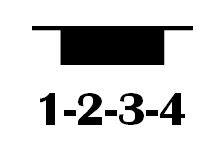| This reading music lesson is a supplement to the Alfred’s Essentials of Music Theory self-study workbook. While no book is perfect for learning how to read music, this is one of the best available. The concise explanations, brief practice exercises, ear-training CD’s, glossary of music terms, and answer key make it an excellent value. Buy this top-rated self-study course for beginners to advanced musicians and follow along with me. |
Music is created by using both sound and silence.
While it’s tempting to just focus on the notes (sound), the rests (silence) are music symbols we don’t want to ignore.
They are just as equally important and give us so much needed variety and contrast.
The first type of rest we will concentrate on is the whole rest.
Whole Rests
Whole rests are similar to whole notes with one difference: Instead of 4 beats of sound, we will have 4 beats of silence.

This means that 4 steady beats of no sound going by (total silence) equals 1 whole rest.
A whole rest looks like an upside down hat or a hole in the ground.

If you can see a flower growing up from the “ground” of this type of rest, then you know it’s a whole rest.
I am showing you this now to help you see the difference between a whole rest and the half rest we are about to learn next.
